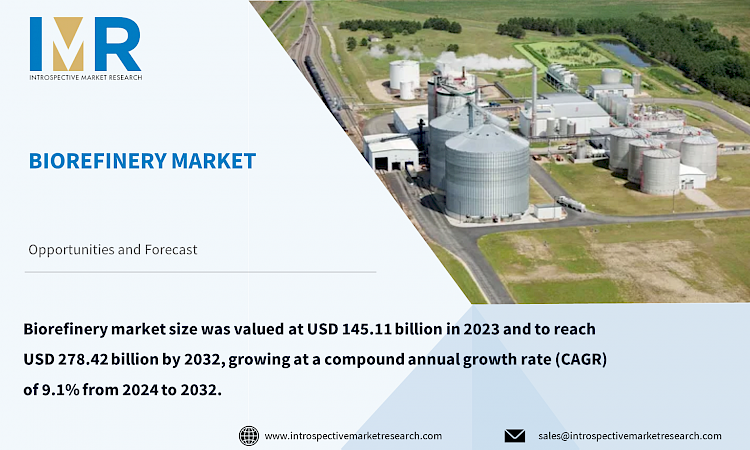Global Biorefinery Market
According to a new report published by Introspective Market Research, titled, “Biorefinery Market by Product, Technology, and Application: Global Opportunity Analysis and Industry Forecast, 2024–2032,”
The global biorefinery market size was valued at USD 145.11 billion in 2023 and to reach USD 278.42 billion by 2032, growing at a compound annual growth rate (CAGR) of 9.1% from 2024 to 2032.
A biorefinery is a versatile facility that employs various technologies to convert biomass, such as agricultural residues, forestry waste, and algae, into a range of valuable products. Unlike conventional refineries that process fossil fuels, biorefineries focus on renewable and sustainable resources. They play a crucial role in the transition towards a more eco-friendly and circular economy.
According to The Biorefinery Market is segmented into Product, Technology, Application, and region. By Product, the market is categorized into Energetic, Nonenergetic. By Technology, the market is categorized into Physio-Chemical, Industrial Biotechnology, Thermochemical, Advanced Biorefinery. By Application, the market is categorized into Resins, Plastic Electricity, Body Care Products. By region, it is analyzed across North America (U.S.; Canada; Mexico), Eastern Europe (Bulgaria; The Czech Republic; Hungary; Poland; Romania; Rest of Eastern Europe), Western Europe (Germany; UK; France; Netherlands; Italy; Russia; Spain; Rest of Western Europe), Asia-Pacific (China; India; Japan; Southeast Asia, etc.), South America (Brazil; Argentina, etc.), Middle East & Africa (Saudi Arabia; South Africa, etc.).
The global shift towards cleaner fuels has gained unprecedented momentum in recent years, driven by mounting environmental concerns and the need to combat climate change. This surge in demand can be attributed to several key factors. Increasing awareness of the detrimental effects of fossil fuel combustion on air quality and greenhouse gas emissions has spurred governments, industries, and consumers to seek alternative, more sustainable energy sources.
Technological innovation has revolutionized the field of biorefinery, driving sustainable solutions for a rapidly evolving world. A biorefinery is a facility that integrates biomass conversion processes to produce a range of valuable products, including biofuels, biochemicals, and biomaterials. Advanced technologies have significantly enhanced the efficiency and versatility of biorefineries
Global Biorefinery Market, Segmentation
The Biorefinery market is segmented based on Product, Technology, and Application and Region.
Product:
Nonenergetic Segment encompasses a wide range of products including biochemicals, biomaterials, and bioproducts. Biochemicals include various compounds such as enzymes, organic acids, and platform chemicals. Biomaterials refer to materials derived from biomass that can be used as alternatives to conventional plastics or materials in various industries. Bioproducts could include a variety of consumer goods and industrial products made from renewable resources.
Technology:
Industrial Biotechnology Biorefinery segment focuses on using biological processes and organisms to convert biomass into valuable products. It often involves the use of microorganisms like bacteria, yeast, or enzymes to produce biofuels, chemicals, and other materials. This segment has seen significant growth, particularly in the production of bio-based chemicals and materials.
Region:
The Asia-Pacific region is endowed with diverse and abundant biomass resources, including agricultural residues, forest residues, and various types of organic waste. This provides a strong foundation for biorefinery operations. Economic Development and Industrialization many countries in the Asia-Pacific region are experiencing rapid economic development and urbanization. This has led to an increase in demand for energy, chemicals, and materials, which can be met through biorefining processes. Biomass Power Generation involves the conversion of biomass into electricity or heat.
Some of the leading Biorefinery market players are
- Clariant (Switzerland)
- Abengoa (Spain)
- Green Plains (US)
- Honeywell International Inc. (U.S.)
- Chempolis (Finland)
- Sekab (Sweden)
- Ørsted A/S (Denmark)
- AB HOLDING SPA (Italy)
- Zea2 Bioworks (U.S.)
- UPM Global (Finland)
- BTS Biogas Srl/GmbH (Italy), and Other Active Players.
Key Industry Development: -
- In February 2022, Governor Greg Abbott announced that USA Bioenergy, through its subsidiary Texas Renewable Funds (TRF), will build a new $1.7 billion advanced biorefinery in Bon Wier, Texas. The biorefinery will convert one million green tons of wood waste into 34 million gallons annually of premium clean burning transportation fuel including Sustainable Aviation Fueal, Renewable Diesel, and Renewable Naphtha.
Key Findings of the Study / Key Industry Developments.
- The global biorefinery market size was valued at USD 145.11 billion in 2023 and to reach USD 278.42 billion by 2032, growing at a compound annual growth rate (CAGR) of 9.1% from 2024 to 2032.
- The Asia-Pacific region is endowed with diverse and abundant biomass resources, including agricultural residues, forest residues, and various types of organic waste.





